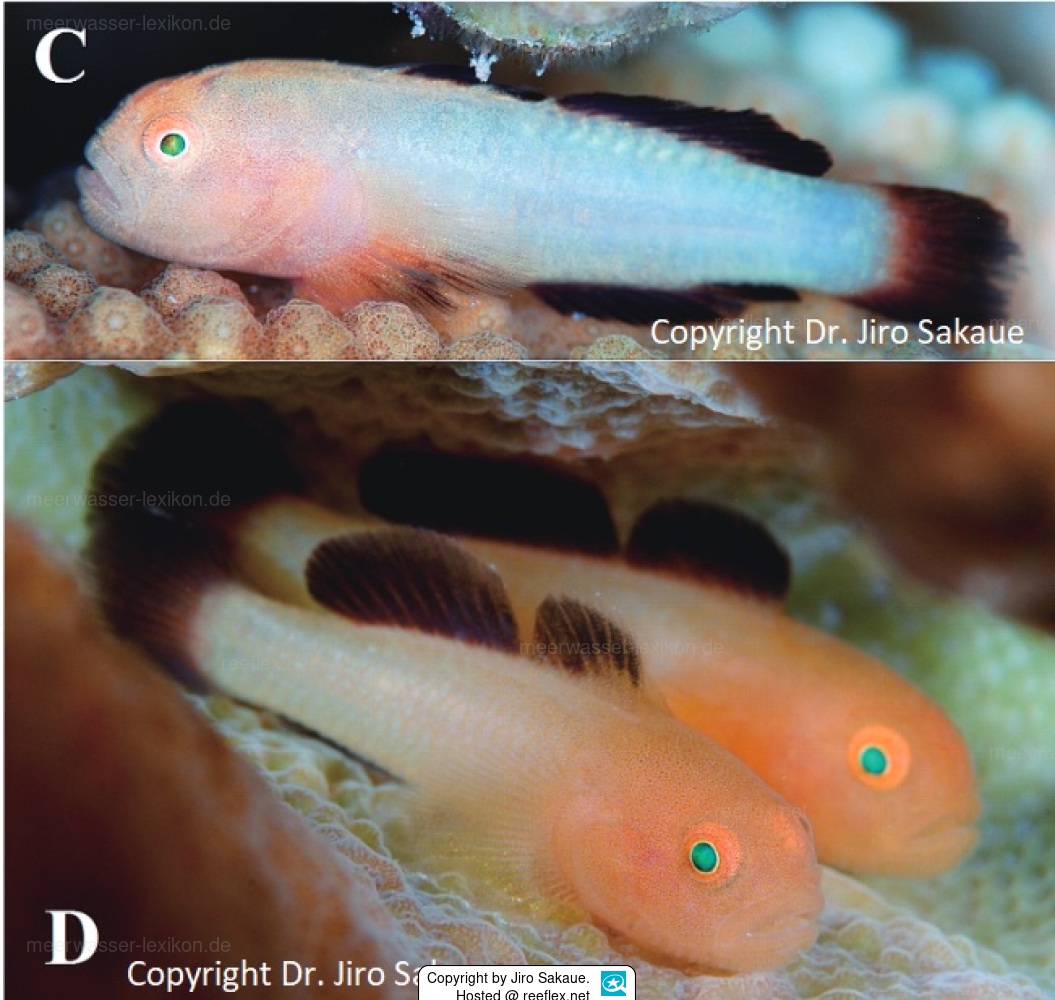Info
Suzuki & Randall, 2011
Very special thanks for the first two photos of Paragobiodon kasaii to Dr. Dr. Jiro Sakaue from Palau, Pacific Ocean!.
Dr. Sakaue has taken his photos at Iriomote Island, the Ryukyu Islands, Japan and Ngemlis Reef, Ngis Island, Palau on the branches of Pocillopora eydouxi Edwards und Haime, 1860 (Suzuki und Shibu-Kawa, 2004).
Paragobiodon kasaii occurs on coral reefs of bays at the reef edge, or on the reef slope at depths of 2–16 m. Individuals live as commensals on the branches of species of coral of the genus Pocillopora, almost Pocillopora eydouxi Edwards and Haime, 1860 (Suzuki and Shibu-kawa, 2004).
Similar species: Paragobiodon lacunicolus (Kendall & Goldsborough, 1911)
Source:
Paragobiodon kasaii , a New Gobiid Fish from Japan and Palau
https://www.kahaku.go.jp/research/publication/zoology/download/37_3/BNMNS_A370305.pdf
Classification: Biota > Animalia (Kingdom) > Chordata (Phylum) > Vertebrata (Subphylum) > Gnathostomata (Superclass) > Pisces (Superclass) > Actinopterygii (Class) > Perciformes (Order) > Gobioidei (Suborder) > Gobiidae (Family) > Gobiinae (Subfamily) > Paragobiodon (Genus) > Paragobiodon kasaii (Species)
Jumping guard
A jumping guard prevents (nocturnal) fish from jumping out.
Wrasses, blennies, hawkfishs and gobies jump out of an unprotected tank in fright if their night rest is disturbed, unfortunately these jumpers are found dried up in the morning on carpets, glass edges or later behind the tank.
https://www.korallenriff.de/en/article/1925_5_Jump_Protection_Solutions_for_Fish_in_the_Aquarium__5_Net_Covers.html
A small night light also helps, as it provides the fish with a means of orientation in the dark!
Very special thanks for the first two photos of Paragobiodon kasaii to Dr. Dr. Jiro Sakaue from Palau, Pacific Ocean!.
Dr. Sakaue has taken his photos at Iriomote Island, the Ryukyu Islands, Japan and Ngemlis Reef, Ngis Island, Palau on the branches of Pocillopora eydouxi Edwards und Haime, 1860 (Suzuki und Shibu-Kawa, 2004).
Paragobiodon kasaii occurs on coral reefs of bays at the reef edge, or on the reef slope at depths of 2–16 m. Individuals live as commensals on the branches of species of coral of the genus Pocillopora, almost Pocillopora eydouxi Edwards and Haime, 1860 (Suzuki and Shibu-kawa, 2004).
Similar species: Paragobiodon lacunicolus (Kendall & Goldsborough, 1911)
Source:
Paragobiodon kasaii , a New Gobiid Fish from Japan and Palau
https://www.kahaku.go.jp/research/publication/zoology/download/37_3/BNMNS_A370305.pdf
Classification: Biota > Animalia (Kingdom) > Chordata (Phylum) > Vertebrata (Subphylum) > Gnathostomata (Superclass) > Pisces (Superclass) > Actinopterygii (Class) > Perciformes (Order) > Gobioidei (Suborder) > Gobiidae (Family) > Gobiinae (Subfamily) > Paragobiodon (Genus) > Paragobiodon kasaii (Species)
Jumping guard
A jumping guard prevents (nocturnal) fish from jumping out.
Wrasses, blennies, hawkfishs and gobies jump out of an unprotected tank in fright if their night rest is disturbed, unfortunately these jumpers are found dried up in the morning on carpets, glass edges or later behind the tank.
https://www.korallenriff.de/en/article/1925_5_Jump_Protection_Solutions_for_Fish_in_the_Aquarium__5_Net_Covers.html
A small night light also helps, as it provides the fish with a means of orientation in the dark!







 Dr. Jiro Sakaue, Palau
Dr. Jiro Sakaue, Palau






